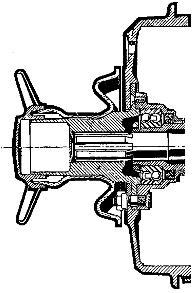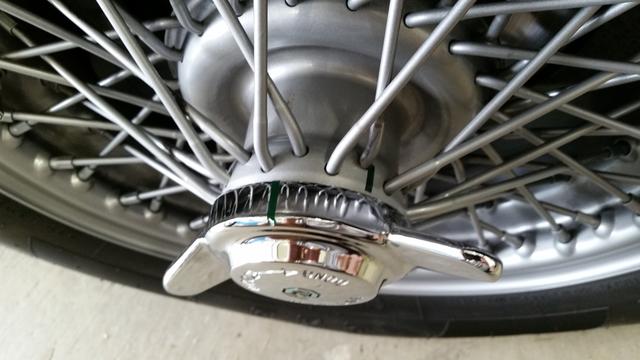The MGA With An Attitude
SELF TIGHTENING KNOCKOFFS - WL-102
Some are marked "LEFT", some are marked "RIGHT", and some just say "UNDO" with an arrow pointing one way or the other. I know some have left handed threads and others have right handed threads. So which ones are supposed to go on which side of the car? And would someone explain why these parts self tighten (or sometimes fall off)?
 At 01:41 PM 12/28/2000 -0600, Jeff Fayne wrote:
At 01:41 PM 12/28/2000 -0600, Jeff Fayne wrote:
>Perhaps an answer lies here, at least the logic appears correct:
>http://www.vtr.org/maintain/wire-wheels-tightening.shtml
Most of the _guesses_ are so far off the wall that you couldn't play handball with them, but this particular explanation is very close but still not quite complete. In fact the cause of self tightening has nothing to do with the construction of the wheel being a wire wheel, as the center lock alloy wheels will do the same thing. And the self tightening action in fact _depends_ on a small amount of clearance in the splines so that the parts can move slightly if the nut is a little loose.
This man's description of the hub construction is correct in that the wheel hub only touches on the conical surfaces at each end of the hub, and the splines come into contact with the driving torque. This part of his statement is also correct, but not doesn't fully explain what that "relative movement" actually is.
"As the car moves forward, a different portion of the wheel rim takes the weight and relative movement occurs between wheel center, locking cap and hub. The effect of this is to tighten the locking cap .... The clearances involved are of course, minute but the locking action is completely positive and entirely automatic."
The "relative movement" he speaks of here is orbital motion like the action of a Hula Hoop (Damn! just how old am I anyway?). As a Hula Hoop orbits around a person's waist it also rotates, with this rotational motion being caused by the difference in the diameter of the two "round" parts.
Another example may be more intuitive. Stand a roll of racers tape on edge, place a very large wrench socket inside of the tape roll, and proceed to roll this assembly along a table top. With gravity the socket remains in the bottom of the tape roll, and as both parts roll along together the smaller part inside will rotate faster because of the smaller diameter.
Now the corresponding parts on the car are the wheel hub and the large threaded nut, and the point of relative rotation is between the tapered contact surfaces. This is easier to understand if you start with the nut loose to begin with so there is a little intentional clearance between the parts. The male taper on the hub is then smaller diameter than the female taper on the nut at the point of contact. As a result, as the car rolls forward both parts are rotating in the forward direction, but the hub will turn slightly faster than the nut, so relatively speaking, the nut on the left side of the car turns clockwise in relation to the wheel as you drive forward, and the nut on the right side turns anti-clockwise, in relation to the wheel. To make these parts self tightening the threads must be right handed threads on the left side of the car and left handed threads on the right side of the car.
And of course the opposite action will also result when the rotation goes the other way. If you tow the car backwards with the front wheels on the ground the large nuts will eventually unscrew (although it may require quite a long travel distance, but less if the nuts is loose to begin with). And if you assemble the hubs to the wrong side of the car the nuts will unscrew while driving forward, and even if they start out very tight you would be lucky to get 100 miles before you lose a wheel.
When the hubs are rotating in the wrong direction, the nut will come totally unscrewed very quickly as soon as it becomes the slightest bit loose. With just 0.001 inch difference in diameter the relative motion of the nut to the wheel will be 0.003 inch with each rotation of the wheel. You can work out the math, but with this much rotation the nut will unscrew one complete turn in about 3 miles of road travel. As the clearance increases the relative rotation increases, and you are surely doomed.
The fellow with the race car with center lock alloy wheels and the hubs on wrong may be okay as long as the knockoffs are very tight at the beginning or each race, the races are not too many miles, and the knockoffs get manually re-tightened periodically. For my own use, I wouldn't take two laps with those hubs on the wrong side of the car.
As to Chrysler's use of left hand threaded nuts on the left side wheels (with steel disk wheels), the principal is the same. But in this case the tapered contact surface on the nut is the smaller diameter part, so the nut rotates in the opposite direction. Theory says you need left hand threaded lug nuts on the left side of the car, but we know that most newer cars have right handed lug nuts all the way around, and so do our MGs. The reason these right handed lug nuts on the left side do not come unscrewed is because the combination of fine threads and large assembly torque applies so much force against the tapered surfaces that the friction will hold the part in place with no relative motion, so the nut stays put.
However, if you should happen to forget to fully tighten the lug nuts after changing a wheel, the left side leg nuts will indeed work themselves off the studs in a short distance of road travel. I suspect some of you must remember having this occur to you at least once, where after perhaps a somewhat hurried wheel installation you find the wheels getting very loose within the first 50 miles of driving, and maybe even sooner. A somewhat alert driver should notice the slightly vague road feel as the wheel becomes noticeably loose, and stopping to tighten the lug nuts is in order, but larger cars with power steering would suppress the feedback considerably.
Please do pay attention to properly torquing the lug nuts. This especially applies to us autocrossing fanatics who have a habit of changing the wheels twice a day on the weekends.
Barney Gaylord
1958 MGA with an attitude
On Feb 11, 2019, Jerry Jesion in Woodhaven, MI, USA wrote:
"I have read and heard that wire wheels are self-tightening. Being an experimentalist I decided to see if it is true. I loosened the nut, then gave it 2 hits with my 4lb HF dead blow hammer. Next, I placed a piece of green pin stripe tape across the nut and hub and then cut it. The following picture was taken after about a 2 mile trip with a max speed of 50 mph. Looks like they do self tighten"!

You can install and tighten the nut by hand, but after driving a few miles you will need a heavy mallet to get it unscrewed.
|

